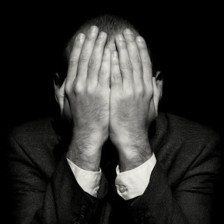After last nights depressing, over-tired post, today turned out to be a good day.
I have been going to church again, mostly for the kids, so that they may know God and understand that somebody may have their back in the bad times, and the good ones.
This has helped me through my BDD, and I figure it is best that they have God’s love to guide them as well.
Going to church helped to get me out of the house, my bedroom and my mind. Writing here on this blog is a lonely outlet, at the end of the day the only way to overcome my BDD is in the presence of others.
It is among others that I can prove (or more likely disprove) my many skin concerns.
Today, sitting in church, in full light, close to people, I could see that no one cared. My facial scar in full view may or may not have caught the attention of others who, in all honesty, seemed to care less. They were more concerned about what I had to say, and I am more concerned about what they have to say.
I feel good when I am out, yes I feel anxious, and yes, I feel self conscious but, at the end of the day, being out and about always has a positive net effect on my attitude.
I stayed after church to sit and write in the open air cafe, afterwards I attended a waffle party with some families that attend my daughters school. One of the dads commented on how he hadn’t seen me around (my daughter just started Kindergarten in October) and I made up some sorry excuse about late nights at work.
Honestly, there is no reason to tell others of my body image concerns. I know my wife was happy to see me there, as were my kids.
Face your Fear and it will Disappear?
My fears have not disappeared But today, out and about, at church, at a party, out on the bike, this afternoon, I started to feel better.
It is hard to believe how I can be on the edge of destruction one moment, and feeling so good the next. This is the nature of the beast when it comes to body dysmorphic disorder. My moods rise and fall like the ocean tides.
Moral of the story: Getting out and being around people is a known cure for depression which, I have along with my BDD. The Lexapro hasn’t seemed to help as much as I would have liked, but then again I need to increase my dose but haven’t been able to in fear of (believe it or not) what the pharmacist will think. This is incredibly irrational and is further proof why I shouldn’t be treating and prescribing for myself.
I skipped my first counseling session this week because I am a coward, and I was tired of talking about my scar.
I wrote a lot here and started to work a bit more on my art. I spent time with my children, I took my wife out on a date, I did avoid the mirrors and I had my wife take the one down at the front door… The last one I see as I head out of the house, it has been known to change my attitude pretty quickly.
My wife continues to be an amazing support of my BDD . She doesn’t give me a bad time about some of my avoidance rituals. She seems to understand what I am going through right now, I am so thankful for that.
I am exhausted, but I made some positive steps this week. My facial scar is hurting me today, I am not sure how much of that is in my mind. But maybe it is because I stretched it today, I showed it to the world, I overcame some fears. And I lived to see another day.
